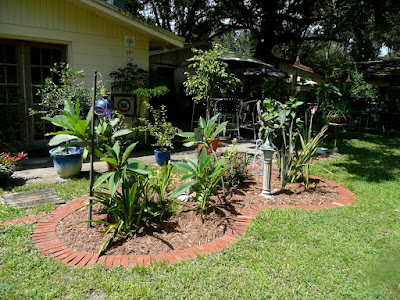Every year about this time the Voodoo Lilies begin to grow. They were here when we bought our house in 1992, and have since been moved to another part of the garden. In 1992, there was no garden, just dirt and sand and these odd tubers. I've since found information about them in several books. We are gradually making our little backyard into our vision of a tropical paradise. In this vision, strange flowers, night bloomers, odd shapes and weird inflorescences abound. Voodoo lilies, also popularly called devil's tongue, corpse flowers or arum, are related to Jack-in-the-pulpit and Amorphophallus titanium (Titan Arum).
The Titan Arum first flowered in the western hemisphere at the New York Botanical Gardens in August 1937. According to
Bizarre Plants
by William A. Emboden, "Visitors other than scientists and reporter-photographers were so numerous that they had to file by the greenhouse and view the the 'beast' through the glass panes. Had they been allowed into the house, the aforementioned stench (very powerful, and suggested a mixture of rotten fish and burnt sugar) might have made many quite ill." Since then, many botanical gardens have successfully grown a flowering Amorphophallus Titanum. Kew Gardens has a very nice
page devoted to this incredible plant.
Our much smaller voodoo lily, blooming for the first time, is probably either Sauromatum guttatum or Hydrosme rivieri. I'm not sure which one. If you know from looking at the picture below, please enlighten me. Our friends, Jimi and Leon had a
much larger bloom a couple of years ago. Leon, a talented photographer, took the linked picture. Ours is just beginning to open to display the red brain-like inflorescence. We have 6 or 7 smaller ones as the tubers multiply. Usually, they grow into attractive small treelike forms from 3 to 6 feet tall with mottled trunks and lush green canopies. We've had heavy rain today (good for tropical paradise!), so I didn't get to smell the flower to see if it really stinks.
You can grow these indoors in cooler climates. How you decide to deal with the stench if it flowers is up to you. I suggest keeping a lot of incense burning. They like humidity and the occasional misting, and are not particular about soil, but don't like a lot of direct sunlight. Besides Bizarre Plants by Emboden, I've come to rely on a book given to me by Jimi and Leon,
David Bar-Zvi
:
The American Garden Guides: Tropical Gardening
. Another fascinating look at the history of strange plants is
Wicked Plants
by Amy Stewart. In July 2009, the St. Petersburg times included a
review of her book. Ms. Stewart grows her own garden of delights full of poisonous flora. With a two and a half year old grandson running around our backyard, I wouldn't hazard growing these, but it is interesting to learn that the sago palm, widely grown in Florida, is highly toxic. All parts of the plant contain carcinogens and neurotoxins and have been know to poison pets who've nibbled on them.
 by William A. Emboden, "Visitors other than scientists and reporter-photographers were so numerous that they had to file by the greenhouse and view the the 'beast' through the glass panes. Had they been allowed into the house, the aforementioned stench (very powerful, and suggested a mixture of rotten fish and burnt sugar) might have made many quite ill." Since then, many botanical gardens have successfully grown a flowering Amorphophallus Titanum. Kew Gardens has a very nice page devoted to this incredible plant.
by William A. Emboden, "Visitors other than scientists and reporter-photographers were so numerous that they had to file by the greenhouse and view the the 'beast' through the glass panes. Had they been allowed into the house, the aforementioned stench (very powerful, and suggested a mixture of rotten fish and burnt sugar) might have made many quite ill." Since then, many botanical gardens have successfully grown a flowering Amorphophallus Titanum. Kew Gardens has a very nice page devoted to this incredible plant. : The American Garden Guides: Tropical Gardening
: The American Garden Guides: Tropical Gardening . Another fascinating look at the history of strange plants is Wicked Plants
. Another fascinating look at the history of strange plants is Wicked Plants by Amy Stewart. In July 2009, the St. Petersburg times included a review of her book. Ms. Stewart grows her own garden of delights full of poisonous flora. With a two and a half year old grandson running around our backyard, I wouldn't hazard growing these, but it is interesting to learn that the sago palm, widely grown in Florida, is highly toxic. All parts of the plant contain carcinogens and neurotoxins and have been know to poison pets who've nibbled on them.
by Amy Stewart. In July 2009, the St. Petersburg times included a review of her book. Ms. Stewart grows her own garden of delights full of poisonous flora. With a two and a half year old grandson running around our backyard, I wouldn't hazard growing these, but it is interesting to learn that the sago palm, widely grown in Florida, is highly toxic. All parts of the plant contain carcinogens and neurotoxins and have been know to poison pets who've nibbled on them.



Comments